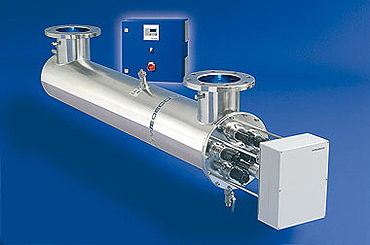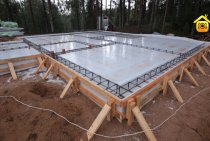Installation of UV radiation at the waterworks in Lovo and its impact on the characteristics of the water supply network.
ANNOTATION.
Stockholm Water has two waterworks, at Lovo and at Norsborg, supplying water to about a million people in the Stockholm area. One of the two production lines of the waterworks in Lovo, which previously used conventional chlorination (sequential addition of ammonium sulfate and sodium hypochlorite), has introduced an ultraviolet disinfection unit and introduced the addition of prepared monochloramine. One of the reasons for the use of ultraviolet radiation and prepared monochloramine was the desire to achieve more effective disinfection of water.
Another important reason was that chlorination of humus-rich water leads to the formation of chlorine-containing by-products and biodegradable organic matter (BOC)
The ultraviolet unit consists of two low pressure Wedeco series K modules, each with a capacity of 3000 m3/h. Each module has 108 lamps. Despite the large number of lamps, we have found that the low pressure technique is more economical due to the fact that it consumes less energy. Prior to the decision to introduce this technology to another production line and other waterworks, a large water sampling and analysis program was launched to determine the impact of the new water disinfection strategy. We were well positioned to investigate the impact of changing the water disinfection strategy as only one of the two lines was converted to the new technology at the waterworks in Lovo, while conventional water chlorination continued on the other. Among other things, these two lines supply water to different segments of the water supply network. Bacterial tests have been concentrated mainly around counting the number of heterotrophic plates (HPLs). It was found that the reduction of HPC in ultraviolet installations is equivalent to three units of the logarithmic scale. However, the HPC value increases rapidly in the pipes and vessels immediately after the ultraviolet unit. Tests have shown that the combination of ultraviolet disinfection and the addition of prepared chloramine does not lead to the formation of an appreciable amount of THM.
INTRODUCTION
In Sweden, surface water treatment facilities represent only about 10% of the total water supply, but they supply water to about 50% of the population. Chlorine is commonly used as a disinfectant for drinking water, and chlorination is the most common water disinfection method used in Sweden. Groundwater is usually supplied without pre-treatment, but sometimes it is treated with ultraviolet radiation.
In Sweden, there are about a thousand ultraviolet units operating in waterworks and water supply systems. The main parts of such ultraviolet plants are low-pressure lamps for the treatment of surface and ground water.
In recent years, much attention has been paid to alternative methods that do not use chlorination. At large waterworks and other water supply enterprises that treat surface water, preference is most often given to ultraviolet disinfection of water.
WATER DISINFECTION STRATEGY.
Notes
- Ryabtsev A. N. // Physical Encyclopedia / Ch. ed. A. M. Prokhorov. — M.: Great Russian Encyclopedia, 1998. - V. 5. - S. 221. - 760 p. — ISBN 5-85270-101-7.
- .
- Bobukh, Evgeny . Retrieved November 6, 2012.
- Soviet Encyclopedia
- L. B. Borisov Medical microbiology, virology and immunology. - MIA, 2005. - S. 154-156
- . docs.cntd.ru. Retrieved February 15, 2018.
- GOST R 53491.1-2009 Pools. Water preparation. Part 1: General requirements (DIN 19643-1:1997)
- . // hindu.com. Retrieved June 17, 2012.
- . //phys.org. Retrieved June 17, 2012.
- Alexander Sergeev. . Posters - Electromagnetic Radiation. elementy.ru (2009). Retrieved 27 October 2019.
UV disinfection technology
UV disinfection is based on the principle of high and low pressure mercury lamps (including amalgam lamps), which emit ultraviolet rays. The unit power of high-pressure lamps is several kW, and low-pressure lamps - tens and hundreds of watts. At the same time, low-pressure mercury lamps have a longer service life and higher efficiency. Amalgam lamps are more energy efficient than high pressure lamps, but the amalgam lamp UV disinfector is less compact.
Industrial UV disinfection systems should be placed taking into account not only the type and number of lamps, the dose of UV radiation, but also the physical and chemical parameters of the environment, general operating conditions.
Benefits of UV technology
-UV disinfection of water and surfaces is a highly effective technology that does not require additional purification, capable of neutralizing the action of many types of microorganisms and cysts. Water purification with ultraviolet disinfects viruses that are resistant to the chlorination method
– UV disinfectant does not affect the physical and chemical properties of air, water and does not form by-products
— Installation of UV disinfection does not require large capital investments and high energy consumption
— UV water disinfection units are compact, easy to operate, and do not require increased security measures.
Sterilization by ultraviolet
To destroy bacteriological contamination (microbes, viruses), ultraviolet sterilizers are used. Steel chambers inside are equipped with UV lamps, placed in special quartz cases, which protect the lamps from contact with water. Ultraviolet rays neutralize all dangerous microorganisms and protozoan cysts in the water. Modern germicidal lamps can last up to one and a half years with continuous operation. Germicidal lamps produce highly effective cleaning. In purified water, there are no organochlorine compounds (unlike chlorination) and ozone impurities, which is an extremely strong oxidizing agent. The lamps are equipped with a control panel and a signaling device that notifies of a malfunction.
Disinfection of water in the local water supply system
UV disinfection of water is also necessary if it comes to the consumer not from a centralized water supply system, but from a local one. Disinfection is carried out after primary cleaning from mechanical impurities. When choosing an installation system, daily water consumption rates are calculated. UV disinfection with the help of bactericidal installations destroys pathogens, viruses that are dangerous to health. The method is more environmentally friendly compared to chlorination. Disinfection with chlorine is an economical method, but it has some disadvantages: the likelihood of allergic reactions, a noticeable chlorine smell. Under the influence of ultraviolet rays of lamps, the destruction of dangerous microorganisms and pathogens of infectious diseases occurs at the cellular level.
When disinfecting water in reservoirs (for example, a swimming pool), an effective method of disinfection using active oxygen is used. If there is a need to remove the smallest particles that the filter does not capture, the coagulation method is used. A highly effective method includes the simultaneous use of ultraviolet rays and ultrasound. At the same time, the taste qualities do not deteriorate and the smell does not appear.
Ultraviolet disinfection of wastewater
Wastewater may contain pathogens of infectious diseases, hazardous toxic substances, carcinogens, and radioactive elements. When treating water with chemicals, there is often an environmentally unsound side effect. UV water disinfection, which is based on an environmentally friendly method, as a result of the cleaning process does not give a side effect. UV disinfection of wastewater destroys chloramine and reduces the level of free chlorine, which prevents chlorine-containing substances from entering water bodies. UV disinfection of water with the help of decontamination devices is a modern method of purification that does not require large operating costs.
Today, industrial UV disinfection systems represent a wide range of standard equipment that has proven itself to be of high quality, efficient and highly technical.
Disinfection of drains with ultraviolet light
This cleaning method deserves special attention. Unlike the methods described above, ultraviolet cleaning is a physical process, therefore, the formation of any chemical compounds that can harm a person is excluded.
Waste water ultraviolet disinfection system
The use of just such a cleaning is recommended for many reasons:
- Unique disinfectant properties, ultraviolet is detrimental to all dangerous microorganisms and spores.
- Ultraviolet disinfection occurs due to intracellular reactions occurring in bacteria, so there is no effect on the water itself.
- The process execution time is minimal, so it can be used in flow-through cleaning systems.
- The cost of such disinfection is an order of magnitude lower than that of other methods.
- The use of UV treatment plants does not pose a potential hazard to humans.
- Modern equipment for performing such a process is small-sized and does not require huge production areas. In addition, the latest developments have made it possible to fully automate the process. Modern electronic systems independently determine the degree of water pollution and set the optimal program of work.
Alternative wastewater treatment methods are quite expensive, so we will not consider them.
In addition to wastewater treatment, sewage sludge is also a significant problem. All solids that have been separated from the effluent during mechanical treatment are potentially hazardous. Without proper treatment, they pose a threat not only to local areas of disease, but even epidemics.
To solve this problem, a variety of methods are used, ranging from simple backfilling with lime to high-tech methods. Disinfection of sewage sludge can be carried out by biological and thermal influence on the sediment mass, you can also resort to devices based on physical principles of influence. For these purposes, ultraviolet, ultrasound, high-frequency currents and even radiation are used.
And although the existing methods of disinfection are far from perfect, it is encouraging that humanity has begun to seriously think about the problem, which means that we still have a chance.

